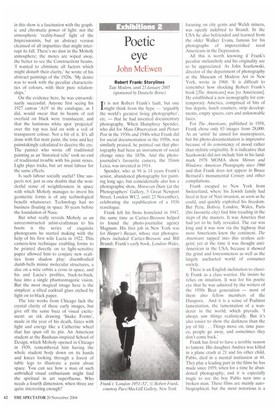Poetic eye
John M c Ewen
Robert Frank: Storylines Tate Modem, until 23 .1 illUILITy 2005 (sponsored by Deutsche Borse)
Tt is not Robert Frank's fault, but one Imight think from the hype — 'arguably the world's greatest living photographer', etc. — that he had invented documentary photography. When Humphrey Spender, who did for Mass Observation and Picture Post in the 1930s and 1940s what Frank did for social documentation in the 1950s, was similarly praised, he pointed out that photography had been an instrument of social change since the 1870s. And the photojournalist's favourite camera, the 35mm Leica, was invented in 1914.
Spender, who at 94 is 14 years Frank's senior, abandoned photography for painting long ago, but coincidentally also has a photographic show, Moroccan Dialy (at the Photographers' Gallery, 5 Great Newport Street, London WC2, until 23 November), celebrating the republication of a 1936 travelogue.
Frank left his Swiss homeland in 1947, the same time as Cartier-Bresson helped to found the photo-journalist agency Magnum. His first job in New York was for Hatper's Bazaar, whose star photographers included Cartier-Bresson and Bill Brandt. Frank's early book, London-Wales, focusing on city gents and Welsh miners, was openly indebted to Brandt. In the USA he also befriended and learned from the older Walker Evans, famous for his photographs of impoverished rural Americans in the Depression.
All this is worth knowing if Frank's peculiar melancholy and his originality are to be appreciated, As John Szarkowski, director of the department of photography at the Museum of Modern Art in New York, wrote in 1968: 'It is difficult to remember how shocking Robert Frank's book [The Americans] was [to Americans]. He established a new iconography for contemporary America, comprised of bits of bus depots, lunch counters, strip developments, empty spaces, cars and unknowable faces.'
For The Americans, published in 1958, Frank chose only 83 images from 28,000. As an 'artist' he aimed for masterpieces, but his photo-documentation is impressive because of its consistency of mood rather than stylistic originality. It is indicative that Szarkowski did not include him in his landmark 1978 MOMA show Mirrors and Windows.American Photography since 1960 and that Frank does not appear in Bruce Bernard's monumental Century and other compilations.
Frank escaped to New York from Switzerland, where his Jewish family had lived in fear of Nazi invasion, as soon as he could, and quickly exploited his freedom. But Peru, Bolivia, London, Wales, Paris (his favourite city) find him treading in the steps of the masters. It was America that had yet to be fully revealed. The car was king and it was now via the highway that most Americans knew the continent. The Americans tapped into this restless zeitgeist; yet at the time it was thought antiAmerican in the USA, because it showed the grind and lonesomeness as well as the largely uncharted world of consumer society.
There is an English inclination to classify Frank as a class warrior. He insists he relies on intuition. It was for his poetic eye that he was admired by the writers of the 1950s Beat generation — most of them also fellow members of the Diaspora. And it is a sense of Psalmist lamentation, the lamentation of a wanderer in the world, which prevails. 'I always saw things realistically. But it's also easier to show the darkness than the joy of life . . . Things move on, time passes, people go away, and sometimes they don't come back.'
Frank has lived to have a terrible reason to lament. His daughter Andrea was killed in a plane crash at 21 and his other child, Pablo, died in a mental institution at 44. They play a leading part in the films he has made since 1959, when for a time he abandoned photography; and it is especially tragic to see the boy Pablo turn into a broken man. These films are mainly autobiographical, but the most notorious is a
banned documentary of the Rolling Stones, some rare screenings of which are programmed at Tate Modern for December.
Frank resumed making photographic works in the early 1970s — publishing and exhibiting contact sheets or collaged, graffitied and film-influenced assemblages. They differ from his early photo-journalism in showing a painterly concern, albeit still using photographic images. He says they represent a shift 'from being about what I saw to being about what 1 felt'; but it is really only a degree of emphasis. Today, a vintage Frank photograph can fetch $80,000, which he finds perplexing. He admits, quoting Johnny Cash, that in old age he still finds himself 'a pilgrim and a stranger'.
At Tate Modern most of the films form a separate programme but his books — some of which are available for visitors to browse — serve his work better than the exhibition. Photographs — especially in the form of Frank's early black-and-whites — do look better in books than pompously strung out as priceless pearls.
The Frank show is neatly complemented by Spender's and also by Milton Gendel: Photographs at Trinity Fine Art (29 Bruton Street, London WI), until 26 November. Gendel went to Italy from America on a scholarship in 1949 and has lived there ever since. Historian, art critic, benefactor and host, he has also taken and annotated 56,000 photographs. This selection, which also comes in a handsome book, combines the social and wittily surreal in Rome and beyond — including a rare informal glimpse of the Queen at Balmoral.



























































































 Previous page
Previous page